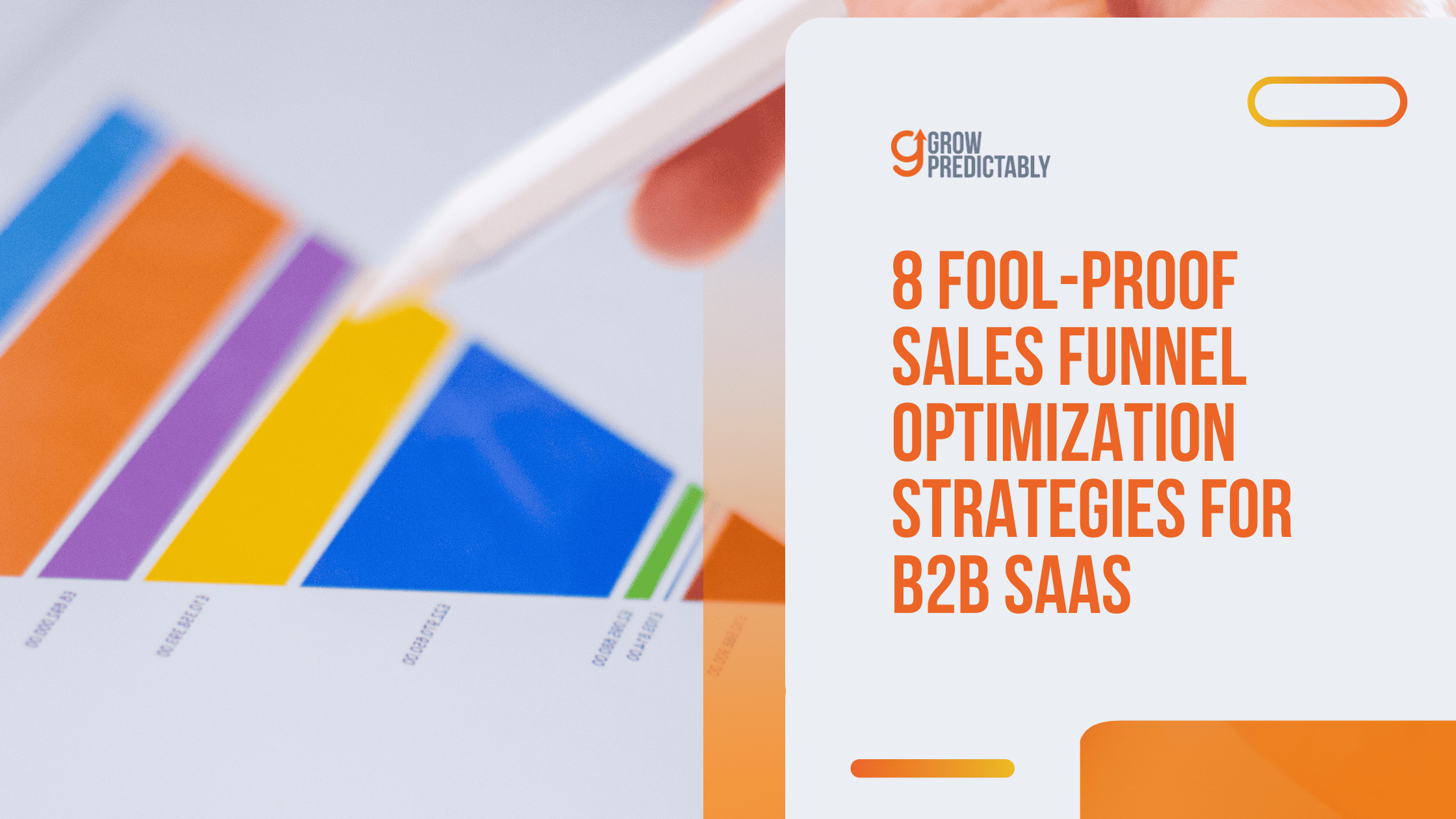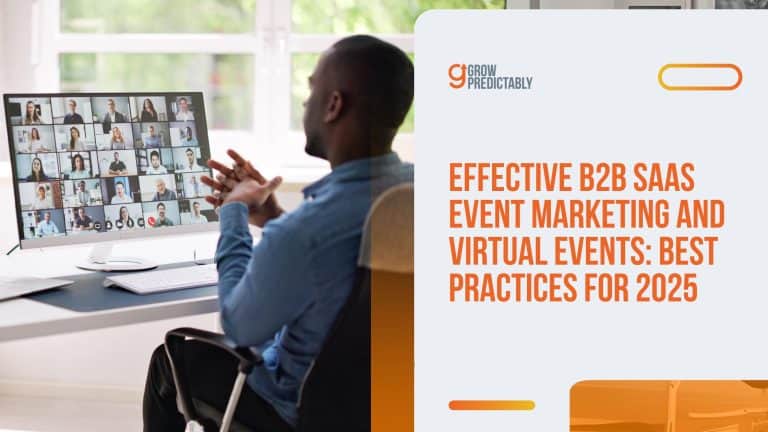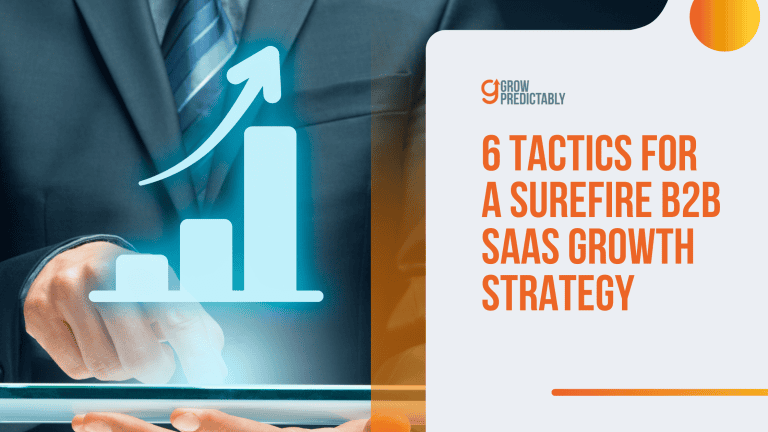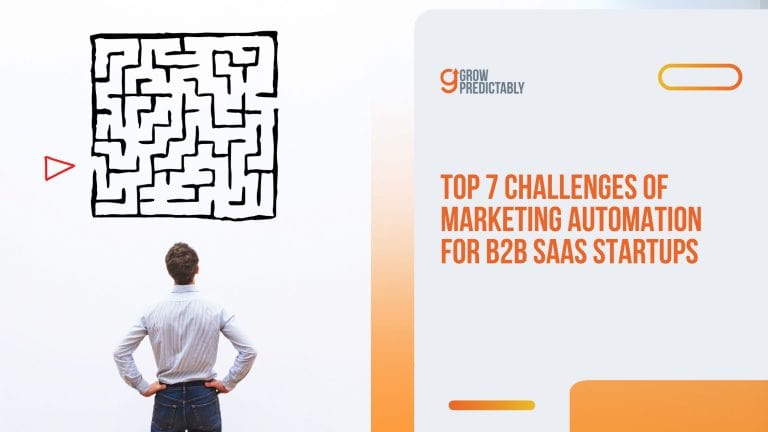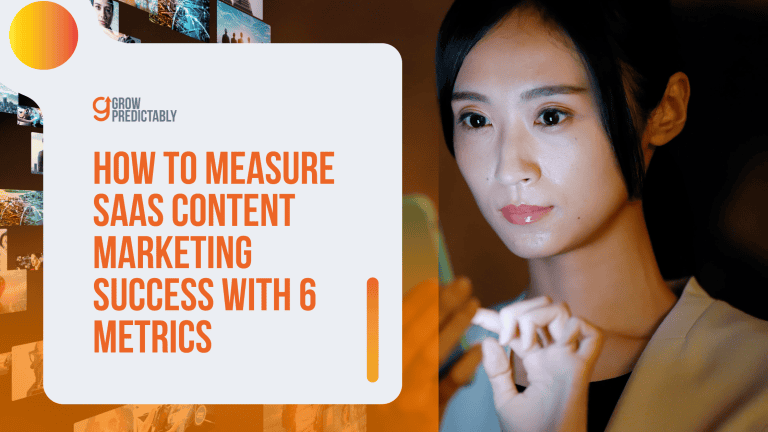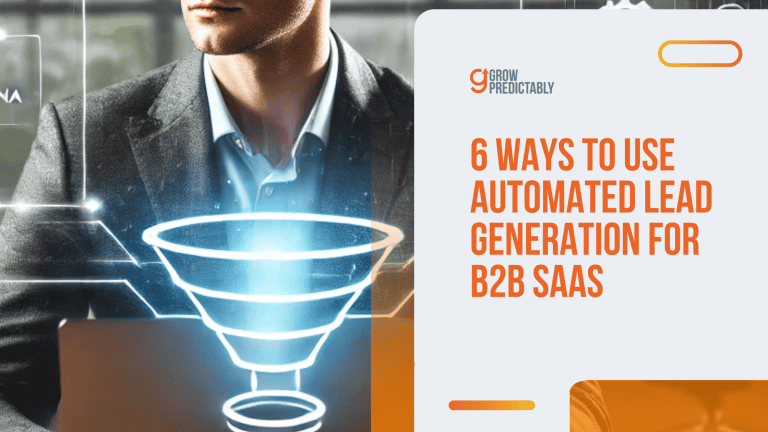8 Fool-Proof Sales Funnel Optimization Strategies for B2B SaaS
B2B professionals often experience something in common when struggling through business growth.
Soaring ad costs, dwindling engagement rates, and leads that just won’t convert.
Does it sound familiar?
For many, it’s a cycle that leads to frustration and many missed opportunities.
But here’s the good news—you don’t need to burn a larger hole in your marketing budget to see better results.
You just need to make your sales funnel work smarter… How?
Let’s simplify how through eight fool-proof sales funnel optimization strategies that are actionable and streamlined for the different stages of the buyer’s journey.
Let’s dive in and start with the very basics.
Identify and Align with Your Ideal Customer
What if knowing your ideal customer could boost your sales conversion rates by 30%?
Many businesses spray and pray with their marketing, throwing content everywhere, hoping something sticks.
But here’s the truth: when you try to speak to everyone, you end up speaking to no one.
For Taxcloud CEO Nate Gilmore, customer understanding is the “first rule in sales and marketing.”

So, let’s explore how understanding your perfect match can transform your B2B SaaS business from constantly chasing leads to attracting the right customers naturally.
The Four Pillars of Customer Understanding
Your ideal customer isn’t just a collection of data points – they’re real people making real decisions.
Let’s break down the essential elements for each funnel stage:
1. Demographics & Interests
- Company size and industry
- Technology stack and budget
- Decision-maker roles and influence levels
2. Fears & Frustrations
- Current workflow bottlenecks
- Resource limitations
- Risk factors in decision-making
3. Wants & Aspirations
- Desired business outcomes
- Career advancement goals
- Company growth targets
4. Key Purchase Drivers
- ROI expectations
- Implementation timeline needs
- Integration requirements
Understanding the four pillars of customer understanding – demographics & interests, fears & frustrations, wants & aspirations, and key purchase drivers – within the marketing funnel can be effectively explored using the Customer Avatar Canvas.
This tool helps B2B marketers create detailed profiles of their ideal customers, ensuring targeted marketing strategies that resonate at every stage of the marketing funnel and buyer’s journey.

By using the Customer Avatar Canvas, marketers gain a comprehensive view of their customers, allowing them to deliver personalized experiences and improve engagement, making it an essential component of any effective B2B marketing strategy.
The 3-Step Framework for Customer Identification
Utilizing tools that help you break down your ideal customers, like the Customer Avatar Canvas, is essential to ensuring your efforts are dedicated to the right audience, whether in marketing or sales.
Aside from using the CAC, it’s also crucial to put in place a framework that will help make identifying your ideal customer an easy process.
Check out this three-step framework outlined below:
Step 1: Segment Your Audience
Start by diving into your CRM data and examining your landing pages.
Look for patterns in:
- Company sizes that consistently convert
- Industries where you’re seeing traction
- Technology stacks that complement your solution
Step 2: Validate Your Assumptions
Don’t guess – confirm.
Run targeted surveys and interviews to understand:
- What triggered their search for a solution
- Their decision-making process
- Key factors that led to choosing (or not choosing) your solution
Step 3: Track Digital Footprints
Use LinkedIn and intent-based tools to:
- Monitor engagement patterns of prospective customers
- Identify common conversation topics
- Spot purchasing signals
EXAMPLE: A project management team struggling with scattered workflows across multiple tools.
Their “before” state includes missed deadlines, confused team members, and frustrated clients.
After implementing the right project management SaaS, they have streamlined operations, clear communication, and happy stakeholders.
This transformation story isn’t just about features – it’s about understanding how to optimize your sales funnel and the emotional journey from pain to solution.
Making It Work: Real-World Application
From my experience tracking website leads and analyzing conversion data, I’ve learned that customers aren’t found – they’re created through understanding and nurturing.
The key is starting with clear customer insights before jumping into marketing tactics.
By knowing exactly who you’re talking to, you can create messages that resonate and offers that convert potential customers.
Your next step?
Take 30 minutes to map out your ideal customer using these pillars and tools like the Customer Avatar Canvas.
You might be surprised by what you discover.
Optimize the Awareness Stage: Content and Social Media Strategies
Picture this: At the awareness stage, your perfect customer is scrolling through LinkedIn right now, but they don’t know you exist.
Let’s fix that!
Here’s the truth about B2B SaaS at the awareness stage – it’s not about shoureting from every rooftop.
It’s about showing up where your decision-makers hang out with content that makes them stop and think, “Wait, this speaks to me.”
Where Your B2B Decision-Makers Really Spend Time
From my experience tracking website leads, I’ve found B2B buyers congregate in three main spaces:
- LinkedIn – But not just posting (they’re deep in industry discussions and professional groups).
- Tech Communities – Places like Reddit’s r/SaaS or specific Slack channels.
- Dark Social – Private podcasts and invite-only forums where real talk happens.
Drawing from my work with clients, the biggest wins come from focusing on one platform first before expanding.
Pick where your audience is most active and master it.
Creating Content That Catches Attention
Want to know what makes B2B content work?
Here’s your game plan for reaching your target audience:
Long-form LinkedIn Posts
- Share real data from your experience
- Tell stories about customer wins
- Break down complex topics into bite-sized insights
Educational Webinars
- Bring in subject experts
- Focus on solving one specific problem
- Record everything for future content
SEO-Driven Blog Content
- Target specific questions your buyers ask
- Create step-by-step guides
- Include actual examples and screenshots
Gated Premium Content
- Industry reports with unique data
- Templates your audience can use today
- Practical tools that save time
For more ideas on the types of content that work best for B2B brands, check out this infographic below.
Which among these content types have you tried and have not tried yet?

These content recommendations are a must-try for every B2B SaaS brand. Among all types of content, these examples are among the most tested and proven in the SaaS space.
When creating high-quality content for B2B marketing, noting what the recent numbers are showing is always a best practice.
- 79% of B2B buyers said they viewed case studies during their purchasing process. (Demand Gen)
- Businesses that use eBooks and whitepapers generate 67% more leads than those that do not. (The Marketing Insider Group)
- Blogging helps companies acquire 55% more visitors compared to those without blogs. (HubSpot)
- Interactive content generates twice as many conversions as passive content. (Content Marketing Institute)
- 86% of businesses use video as a marketing tool. (HubSpot)
Making Your Content Work Harder
Remember that webinar you just recorded?
Turn it into:
- 5-10 short LinkedIn posts
- A blog post series
- Email newsletter content
- Social media snippets
The Secret Sauce: Storytelling That Sells
Here’s what makes B2B buyers stop scrolling – stories about companies just like theirs solving problems they’re facing right now.
Structure your stories like this:
- The situation they’re in
- The struggle they’re facing
- The solution that worked
- The specific results achieved
Quick Wins You Can Try Today
- Write one detailed LinkedIn post about a problem you solved.
- Join 3 relevant tech communities and start engaging.
- Plan your first educational webinar.
- Create one piece of gated content.
REMEMBER: You don’t need to be everywhere.
You need to be where your buyers are, sharing content that helps them succeed.
Want to see how this all comes together for potential customers?
Stay tuned – we’ll explore advanced micro-content strategies in the next section.
Enhance the Interest Stage: Lead Nurturing and Free Trials
Ready to turn those curious prospects into excited customers?
Let’s say a potential customer just finished downloading your whitepaper. Now what?
The magic happens in how you guide them toward that “yes.”
Let’s dig into proven lead-nurturing strategies that will keep your SaaS offering top of mind.
Here’s your roadmap for conversion funnel optimization and nurturing leads through three key stages:
1. Spark Engagement
- Send bite-sized tips via email (think 2-minute reads)
- Create quick-win worksheets they can use right away
- Build interactive tools (like ROI calculators) that showcase your value
2. Secure That Subscribe
- Package your best insights into downloadable guides
- Give early access to new features
- Share exclusive industry research
3. Guide Toward Conversion
- Start with a no-pressure free trial
- Offer a small “proof of concept” test
- Remove friction (like requiring credit cards upfront)
Did you know there are multiple case studies showing a boost in trial signups at this funnel stage just by removing the credit card requirement?
The quality of leads stayed strong because they focused on delivering value fast.
Remember that eliminating barriers to entry (like requiring credit card information) is an important conversion best practice, too!
Smart Email Nurturing That Works
As one of the leading mediums for lead nurturing, here’s how you can best leverage your emails:
- Space out emails every 2-3 days
- Mix educational content with gentle product hints
- Track which topics get the most clicks
- Test different subject lines (numbers often win)
Free Trial Success Tips
When it comes to the interest or excitement stage, leveraging free trials is always part of the strategy.
Why?
According to data, free trials can significantly boost B2B conversions, potentially increasing them by as much as 66%. (Source)
Successful Free Trial Implementation
A notable example of a successful free trial campaign is seen in companies that leverage opt-in free trials to boost conversions.
For instance, BigContacts, a CRM provider, significantly increased free trial sign-ups by optimizing their pricing page and making the free trial offer more prominent.
This strategic move led to a 76% increase in visits to the free trial page.
What made it successful:
- Clear Value Proposition: The company effectively communicated the benefits of their CRM solution, aligning it with potential customers’ needs.
- Simplified Sign-up Process: By minimizing barriers to entry, they encouraged more users to try their product.
Actionable Steps for Your B2B Free Trial
To replicate the success of this free trial case study, here are a few points for you to remember.
- Engage Proactively: Use targeted communications and support to guide users toward conversion. Check-in personally with bigger accounts.
- Streamline Registration: Keep the sign-up process simple and straightforward. Follow it up with guided tour emails showing key features.
- Communicate Value Early: Make the first win happen fast (within 5 minutes). Highlight core features and benefits clearly during the trial.
- Personalize Onboarding: Tailor the experience to address specific user pain points.
From my knowledge, the sweet spot for a SaaS trial length is 14 days.
It creates enough urgency while giving users time to see value.
Red Flags to Watch
- Sending too many emails too fast
- Making trial setup complicated
- Forgetting to follow up with inactive users
- Not measuring what works
Quick Wins You Can Try Today
- Set up a welcome email showing their next steps
- Create a simple onboarding checklist
- Track which features trial users actually use
- Follow up with anyone who gets stuck
REMEMBER: Your goal isn’t just getting signups – it’s helping customers succeed.
When they win, you win.
Want better results from your landing pages? Test everything.
Try different trial lengths, email timing, and onboarding steps.
Let the data guide your choices.
Start small, measure results, then scale what works.
Maximize the Consideration Stage: Case Studies and Personalization
Picture this: Your potential customer is scrolling through dozens of SaaS solutions.
What makes them stop and pick yours to optimize your sales funnel?
The X factor is when they start seeing themselves in your success stories.
Here’s what I’ve found effective: Real numbers grab the attention of prospective customers faster than generic promises!
Let’s break down how to make your case studies and personalization work harder for you to optimize your sales funnel.
Power Up Your Case Studies
Start with your wins that pack the biggest punch.
Pick stories showing clear, measurable results, like a company cutting its workflow time by 30% using your platform.
Structure your success stories like this:
- Paint the “before” picture (their struggles)
- Show your solution in action
- Hit them with specific results (time saved, money earned, problems solved)
From tracking website analytics, I’ve noticed that case studies with specific numbers get 2-3x more engagement than general testimonials.
Baremetrics follows this same framework at the beginning of each case study they feature.
Just like their case study “Cancel Timeshare Recovered $680 in 1 Month With Baremetrics.”

Starting each case study off with a summary of the client’s problem, the solution you’ve provided, and the results of your collaboration helps B2B decision makers digest the value you’ve created more conveniently.
They also explicitly mentioned the figures that the case study achieved in the title itself.
Make It Personal (Really Personal)
Generic messages don’t cut it anymore.
Here’s what works:
- Study your CRM data to spot patterns in what different customers care about
- Create custom landing pages that speak to specific industries
- Send targeted emails based on how people use your product
Think Amazon-style smart recommendations, but for B2B.
When someone’s checking out your enterprise security features, show them case studies from similar-sized companies in their industry.
Trust Signals That Matter
Remember – B2B buyers need solid proof before they commit.
Include:
- Detailed ROI calculations
- Security certifications (if relevant)
- Integration capabilities with their existing tools
Drawing from my knowledge of customer behavior, I’ve found that showing compatibility with popular tools like Salesforce or Microsoft often speeds up decision-making.
Keep It Real
Your customer’s journey isn’t a straight line – they might bounce between case studies, pricing pages, and feature comparisons multiple times on their customer journey.
That’s normal.
Focus on making each touchpoint valuable and connected.
PRO TIP: Track which case studies resonate most with different segments.
Use this data to refine your targeting.
You have to remember that you’re not just selling software – you’re selling transformation.
Your case studies should tell that story.
Streamline the Purchase Stage: Trust Signals and Checkout Optimization
Picture this: A potential customer is ready to buy your SaaS product.
They’ve read your case studies, watched your demos and their fingers hover over the “Purchase” button.
But something makes them pause.
What happens next could make or break your sale.
From my experience working with SaaS companies, I’ve seen purchase rates jump 25% just by adding the right trust elements at crucial moments.
Let’s break down how to turn those hesitant clicks into confident purchases.
Build Trust Through Social Proof
Start by placing trust signals where they matter most:
- Show real customer testimonials next to pricing options
- Display security badges prominently during checkout
- Add customer logos from recognized brands
- Include real-time stats on your landing pages (like “50+ companies signed up this week”)
PRO TIP: Pick customer testimonials that speak to common buying concerns.
For example, if you’re selling project management software, highlight quotes about easy team adoption or quick ROI.
Reduce Friction in Your Checkout Flow
Think of your checkout process like a smooth highway – every speed bump risks losing a sale.
Here’s how to keep traffic flowing:
- Minimize form fields to essential information only
- Enable auto-fill for common fields
- Offer single sign-on options
- Make the process mobile-friendly (40% of B2B research happens on mobile)
Drawing from my digital analytics background, I’ve found that each additional form field can drop conversion rates by 7%.
Keep it simple!
Provide Payment Flexibility
Modern B2B buyers expect options.
Consider offering:
- Monthly and annual billing choices (with attractive annual discounts)
- Multiple payment methods through Stripe integration
- Enterprise billing options (like invoicing)
- Clear money-back guarantees
Add Human Touch Points
Sometimes technology needs a human backup:
- Install live chat support during checkout hours
- Offer instant demo scheduling for hesitant buyers
- Provide clear links to help with documentation
- Include a direct phone line for urgent support
I’ve seen this work firsthand – one SaaS client saw a 15% boost in conversions after adding live chat during business hours.
Combat Cart Abandonment
Don’t let potential customers slip away:
- Send gentle reminder emails to potential customers within 24 hours
- Highlight what they’re missing out on
- Offer time-sensitive discounts thoughtfully
- Ask for feedback if they don’t return
Your goal isn’t just to make the sale – it’s to start a long-term relationship.
Every element of your checkout process should reinforce that you’re a trustworthy partner.
Next up, we’ll explore how to turn these new customers into loyal advocates through strategic post-purchase nurturing.
But first, make sure you’ve implemented these checkout optimization strategies – they’re your foundation for sustainable growth.
Post-Purchase Nurturing: Retention and Advocacy Strategies
Getting a customer to buy is just the beginning.
The real magic happens when they become raving fans who stick around and bring their friends along for the ride.
Let’s dive into proven strategies that turn one-time buyers into long-term advocates.
I’ve seen firsthand how focusing on retention can transform a SaaS business – it’s like watching a garden grow from a single seed into a thriving ecosystem.
Building Your Retention Engine
Start with these three key pillars:
1. Proactive Customer Success
- Schedule quarterly business reviews to showcase ROI
- Set up executive check-ins at key milestones
- Create custom success plans for each customer segment
2. Community Building
- Launch private Slack channels for user discussions
- Host monthly virtual meetups for knowledge-sharing
- Recognize power users with exclusive badges
3. Strategic Referral Programs
- Offer extended trial periods for successful referrals
- Give account credits for bringing in new customers
- Highlight customer success stories in case studies to enhance trust and customer satisfaction
Measuring What Matters
Track these vital signs to gauge your retention health:
- Net Promoter Score (NPS): Survey customers regularly
- Retention Rate: Monitor monthly and annual figures
- Expansion Revenue: Track upsells and cross-sells
- Feature Adoption: Measure usage of key functions
PRO TRIP: Use a simple Growth Scorecard to track these metrics weekly.
Color-code them (red, yellow, green) to spot trends quickly.
Making It Personal
It’s also worth noting that retention isn’t just about numbers – it’s about relationships.
One strategy I’ve found particularly effective is creating personalized quarterly impact reports.
These show customers exactly how your product has improved their business, making renewal decisions a no-brainer.
For example, a customer success manager might say: “Looking at your data, you’ve saved 20 hours per week on manual tasks since implementing our solution. That’s equivalent to hiring a half-time employee!”
Creating Effective Quarterly Impact Reports for B2B Businesses
Quarterly impact reports are a powerful tool for nurturing customer relationships and demonstrating value post-purchase.
By clearly illustrating the benefits your solutions provide throughout the sales funnel, you can enhance customer satisfaction and promote retention.
Here’s a simplified guide and template for creating impactful reports:
Simple Template for Quarterly Impact Reports
[Company Name] Quarterly Impact Report
Client Name: [Client Name]
Quarter: [Q1/Q2/Q3/Q4]
Date: [Date]
1. Executive Summary:
- Brief overview of the quarter’s highlights and key outcomes.
2. Key Metrics:
- Time Saved: [e.g., 20 hours/week]
- Cost Reduction: [$X]
- Productivity Increase: [X%]
- Revenue Growth: [$X or %]
3. Achievements:
- Achievement 1: Description
- Achievement 2: Description
4. Challenges and Solutions:
- Briefly describe any challenges faced and solutions implemented.
5. Recommendations:
- Action 1: Recommendation
- Action 2: Recommendation
6. Visual Data Insights:
- Attach graphs/charts illustrating significant metrics and trends.
Contact Information:
- Feel free to reach out for any queries or further discussion.
Effective Distribution Channels for Quarterly Impact Reports
Once you’ve created your impact reports, consider the following channels for distribution.
Making this part of the post-purchase phase as personalized as possible helps improve customer retention.
- Email: Send reports via personalized emails directly to clients. Ensure the email highlights the report’s key findings and value.
- Client Portals: If applicable, upload the reports to a dedicated client portal where clients can easily access and review them.
- Virtual Meetings: Schedule a video call to present the report and discuss the findings with clients. This personal interaction reinforces the relationship.
By systematically creating and distributing personalized quarterly impact reports, B2B professionals can demonstrate ongoing value, fostering stronger relationships and enhancing customer loyalty.
Building Your Advocacy Army
Turn happy customers into active promoters through:
Ambassador Programs
- Invite top users to beta test new features
- Feature them in marketing materials
- Provide exclusive training sessions
Success Celebrations
- Share customer wins on social media
- Create awards for innovative product use
- Highlight customer stories in newsletters
Community Leadership
- Empower users to lead discussion groups
- Create mentor programs for new customers
- Recognize top contributors regularly
The Power of Proactive Support
Don’t wait for problems to arise.
Schedule regular check-ins and use automation to identify at-risk accounts early.
This approach has helped countless SaaS companies spot issues before they lead to churn.
According to Harvard Business Review, a 5% increase in retention can boost profits by 25-95%. (Source)
That’s why focusing on post-purchase nurturing isn’t just nice – it’s necessary for sustainable growth.
Taking Action Today
Start small, but start now:
- Pick one retention metric to track weekly
- Create a simple customer feedback loop
- Launch a basic referral program
- Schedule regular check-ins with key accounts
The key to a successful conversion funnel is consistency.
Keep showing up for your customers, and they’ll keep showing up for you.
By implementing these strategies, you’re not just reducing churn – you’re building a community of loyal advocates who’ll help grow your business naturally and sustainably.
The Power of AI-Driven Lead Scoring
Gone are the days of guessing which leads deserve your attention.
Modern AI tools analyze hundreds of data points to identify your hottest prospects automatically.
For example, Clearbit’s AI examines company firmographics, technographics, and behavioral signals to score leads based on their likelihood to convert.
This means your sales team focuses on qualified prospects who match your ideal customer profile.
In general, sales teams go through the following steps when scoring their leads.

Smart Segmentation That Scales
AI doesn’t just score leads – it groups them intelligently.
Tools like HubSpot’s AI can automatically segment your audience within the conversion funnel based on:
- Industry vertical
- Company size
- Technology stack
- Engagement patterns
- Purchase intent signals
This automated segmentation enables personalized messaging at scale.
Instead of manually tagging contacts, AI handles the heavy lifting while ensuring prospective customers receive relevant content.
Predictive Analytics: See the Future
One of the most powerful applications of AI is predicting customer behavior.
Using historical data and machine learning, tools can forecast:
- Which leads are most likely to convert
- When customers might churn
- Optimal times for upgrade offers
- Best-performing content types
This predictive power lets you get ahead of issues with your target audience before they happen.
For instance, when AI flags a customer as high-risk for churn, your success team can proactively reach out.
Measuring Impact with the Growth Scorecard
To track how well your AI automation performs, use a simple Growth Scorecard system:
🔴 Red: Manual processes are eating up time
🟡 Yellow: Basic automation in place
🟢 Green: AI-optimized and continuously improving
To make the process more organized and easy to track, use a spreadsheet template like the one below.

Track these key metrics:
- Lead response time
- Lead qualification accuracy
- Sales team productivity
- Customer engagement rates
- Churn prediction accuracy
Getting Started with AI Automation
Begin with one area of your funnel:
- Map your current manual processes
- Identify repetitive tasks
- Research AI tools that could aid in conversion funnel optimization
- Start small and measure results
- Scale what works
Remember: AI complements your team’s skills – it doesn’t replace them.
Use automation to handle routine tasks so your people can focus on building relationships and solving complex problems.
Ready to automate your funnel?
Start by auditing your current processes to spot automation opportunities.
In the next section, we’ll explore how to test and optimize your automated workflows for maximum impact.
Monitor and Iterate: Analytics and A/B Testing Strategies
Ever wonder why some SaaS companies seem to nail their conversion rates while others struggle?
The secret isn’t luck – it’s systematic testing and refinement.
Let’s dive into how you can use data to transform your funnel performance.
The Growth Scorecard System: Your Testing Compass
Think of the Growth Scorecard as your funnel’s health check.
Using a simple Red-Yellow-Green system, you’ll quickly spot where your funnel needs attention:
🔴 Red: Conversion rates below industry benchmark
🟡 Yellow: Meeting basic standards but room for growth
🟢 Green: Exceeding targets
From my experience working with SaaS clients, focusing on red areas within the conversion funnel first gives you the biggest wins.
Optimizing the conversion stage in B2B sales funnels is crucial because it directly impacts revenue generation compared to other stages of the funnel.
Digital marketing pioneer and author Jeff Eisenberg even said, “It’s much easier to double your business by doubling your conversion rate than by doubling your traffic.”
Focusing on the conversion stage ensures that efforts are concentrated on converting qualified leads into paying customers, maximizing the return on investment in earlier stages.
This strategic focus can significantly enhance overall business performance and revenue.
I’ve seen companies double their conversion rates just by fixing these critical spots.
Strategic A/B Testing Framework
Follow this proven approach to maximize your testing impact:
Identify Testing Priorities
- Review your Growth Scorecard metrics
- Focus on high-traffic, low-converting pages for conversion funnel optimization
- Pick one element of your landing pages to test at a time
Design Your Test
- Create clear hypotheses
- Set minimum sample sizes for each funnel stage
- Define success metrics
- Plan test duration (minimum 2 weeks)
Monitor and Document
- Track both primary and secondary metrics
- Document all test variations
- Note external factors that might impact results
A key insight from my digital marketing work: Small changes often drive big results.
Common Testing Pitfalls to Avoid
- Testing too many elements at once
- Ending tests too early
- Ignoring statistical significance
- Not documenting test conditions
Your Next Steps
- Pull up your funnel metrics right now
- Mark each stage Red, Yellow, or Green
- Pick your biggest “red” area
- Design one clear test
- Start measuring tomorrow
REMEMBER: Perfect data isn’t the goal – better decisions are.
Start testing something today, even if it’s small.
Your future self will thank you.
Drawing from my background in data-driven marketing, I’ve learned that tracking progress weekly using simple scorecards beats complex monthly reports.
It helps you spot trends faster and adjust course quickly.
Next up, we’ll explore advanced testing techniques that can push your conversion rates even higher.
But first, put these sales funnel basics into action – they’re proven to work.
FAQs
The Road to Better Conversions Starts Here
Understanding your ideal customer isn’t just about demographics—it’s about aligning with their needs, desires, and behaviors to drive real business growth.
By segmenting your audience, validating assumptions, and tracking digital footprints, you can take the guesswork out of marketing and start attracting the right customers effortlessly.
Now, imagine the impact this could have on your business.
More engaged leads, higher conversion rates, and customers who feel truly understood. Isn’t that worth investing time in?
Start today by mapping out your customer avatar using the framework outlined here.
If you’re looking for deeper insights, check out our recommended reading on customer psychology and B2B marketing trends.
What’s the biggest challenge you’ve faced in defining your ideal customer? Share your thoughts in the comments—we’d love to hear them!
By refining your approach, you’re not only improving your sales but also setting your business up for sustainable growth in a competitive market.

